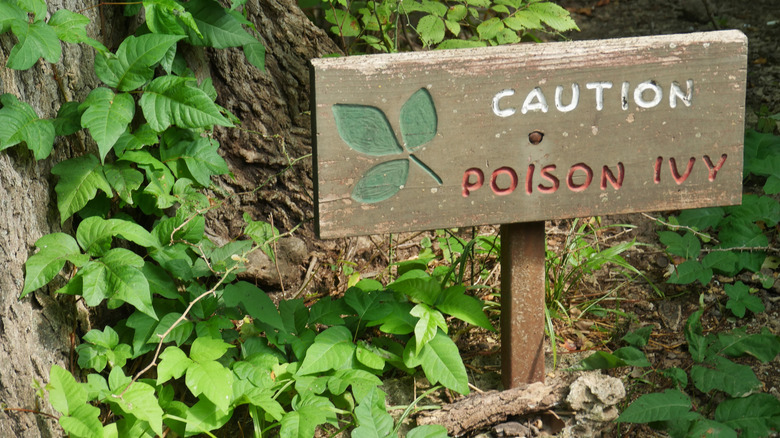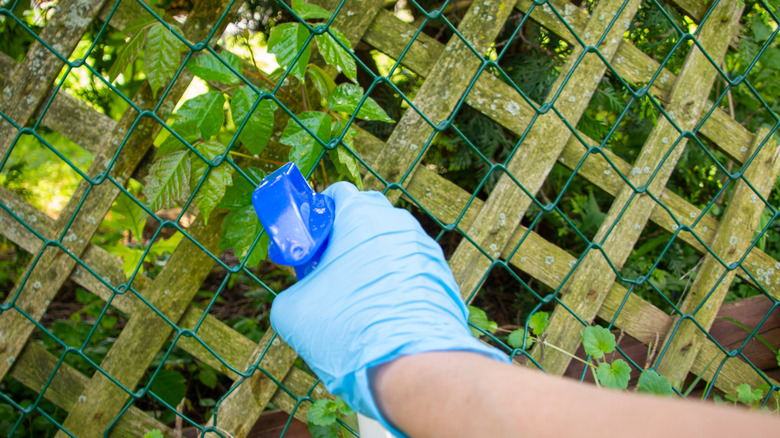The DIY Vinegar Solution Can Help Kill Poison Ivy
No one wants poison ivy (Toxicodendron radicans) in their yard, as the risk of exposure and infection is just too large. Unfortunately, this weed is hardy and persistent, growing in almost any conditions and crowding out other flora. So if you find some making its way onto your property, it can be incredibly hard to get rid of. Chemical weed killers are an option, but not only are they harmful to the environment, they can also be toxic to humans. For these reasons, many people look for DIY, natural weed solutions, and there's one in particular that uses vinegar and salt.
While poison ivy can be pulled out of your yard, it's a very delicate process that should not be undertaken by anyone particularly sensitive to the urushiol oil that causes the plant's distinctive rash. Moreover, once pulled out of the ground, the plant can't be burned or composted. Burning poison ivy creates a smoke that is unhealthy to breathe, while throwing it in a compost pile is a good way to help it grow in another part of your yard. A herbicidal spray may be a much better poison ivy removal option.
Making the vinegar and salt weed killer
Because of its hardiness and adaptability, getting rid of poison ivy can be a difficult task. Chemical herbicides can be harmful to anything they come in contact with including grass, trees, pets, and human skin. Meanwhile, boiling water is a totally safe and organic solution but it might only kill the leaves and vines above ground. Even homemade sprays might not work right away with such a persevering plant. However, the vinegar and salt weed killer is effective against the stubborn poison ivy plant when used with patience and consistency.
To make this DIY weed killer, add 1 cup of salt, 1 tablespoon of dish soap, and 1 tablespoon of vinegar to 1 gallon of water. Mix well and fill up a spray bottle with the solution using a funnel. Spray this all over the plant, from the root heads at ground level all the way up to the highest leaves. Because this is a mostly natural product, it won't be dangerous to animal life. A regular spraying schedule — say once or twice a week — should make quick work of the plant's leaf and vine structure, leaving only the roots to be pulled.
Tips on using this DIY herbicide to eradicate poison ivy
Unlike chemicals that are quickly absorbed into the plant and transported into the root structure, DIY weed killers tend to simply dry out the leaves and stems without ever reaching the roots at all. Unfortunately, poison ivy has an extensive root system that reaches far and wide, so for the DIY weed killer to work, you've got to get it on the roots or pull the entire root system up out of the ground. That's why repeated use, patience, and thoroughness is recommended.
The acidic nature of the vinegar will dry out the poison ivy wherever it's applied, so it's important to spray every area of the plant. Additionally, it's important to be precise in your spraying techniques, because vinegar can also dry out grass and any other plants nearby. Similarly, table salt can be harmful to soil nutrients and its ability to grow things in the future, so you need to make sure you're spraying directly onto the poison ivy plant and nowhere else. Furthermore, you'll have to treat the plant multiple times to make sure all of the greenery dies away along with as many of the roots as you can see. If the plant continues coming back, it means the roots have not been properly eradicated and that you may need to pull them out of the ground. Otherwise, if this natural solution isn't working, a chemical solution might be the only viable answer.

